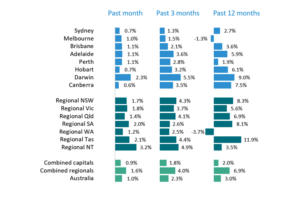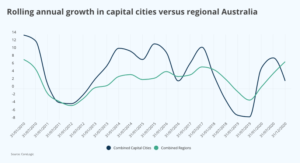Regional Australian towns increasingly popular with home buyers
News
News
Regional towns in Australia are leading the way when it comes to house price gains as growing numbers of city residents make a ‘tree-change’ to smaller urban areas.
Driven by the work-from-home trend, a desire for homes with larger living space and gardens, and societal changes brought on by the COVID-19 pandemic, regional towns are proving popular for home buyers.
In 2020 homes in regional areas rose by 6.9 per cent, a capital gain three times that of the average rise for Australian cities, according to real estate research firm Core Logic.
“Regional housing markets had generally underperformed relative to the capital city regions over the past decade, but 2020 saw regional housing values surge as demand outweighed supply,” Core Logic research director, Tim Lawless, said.

Some regional areas, mostly coastal towns, have performed just as well as Australian cities over a longer, 10-year period in terms of annualised capital gains.
In NSW, regional towns in the Illawarra, Newcastle Lake and Southern Highlands areas achieved annualised gains of 4.5 to 5 per cent over the past decade.
This compares to an annual average of 5.1 per cent across the Sydney housing market, and 2.1 per cent for other NSW regions.
In Victoria, the hottest housing spot is Geelong which has notched up annual growth of 4.1 per cent to 2.7 per cent for other Victorian regional towns.
Queensland’s Gold Coast and Sunshine Coast housing markets have seen annual growth of 1.5 per cent, which is in line with Brisbane’s market.

Population growth is a significant driver of housing prices and has tended to be higher in coastal regional areas such as the Gold Coast over the past 10 years.
The drift from city to region, has been in play for some time, but has been accelerated by the COVID-19 pandemic, said Core Logic.
“This is because relatively strict restrictions were implemented across major capital cities, and remote work has been increasingly enforced as a way to combat the spread of COVID-19,” said Core Logic’s head of residential research, Eliza Owen.
Proximity of regional towns to major cities is another positive factor for housing prices in coastal areas.
The rise of cities within a ‘commutable distance’ to capital cities has enabled a regional lifestyle with the benefit of maintaining access to the employment opportunities and amenity of capital cities.
“This combination has attracted a greater price premium over time,” said Owen.